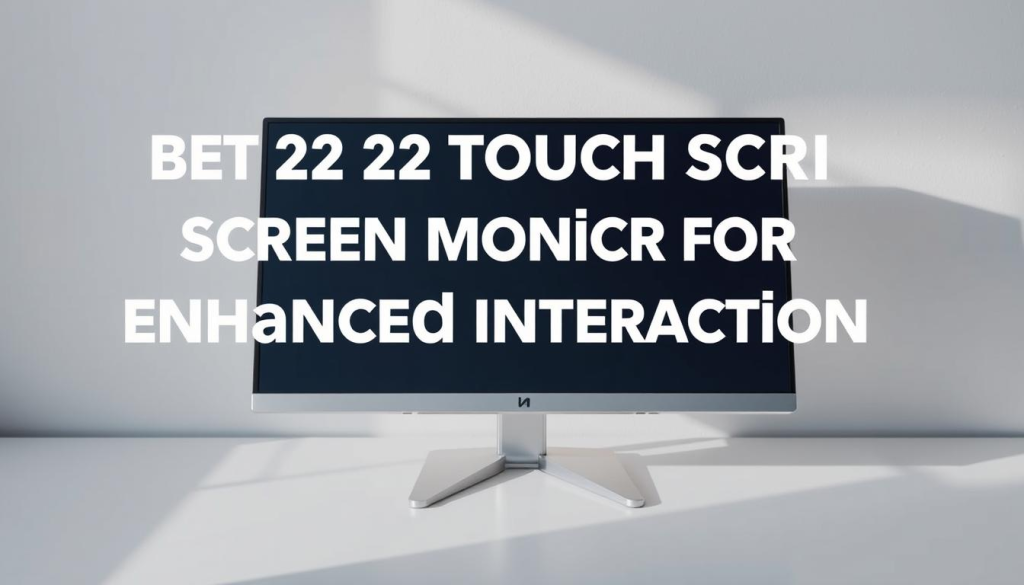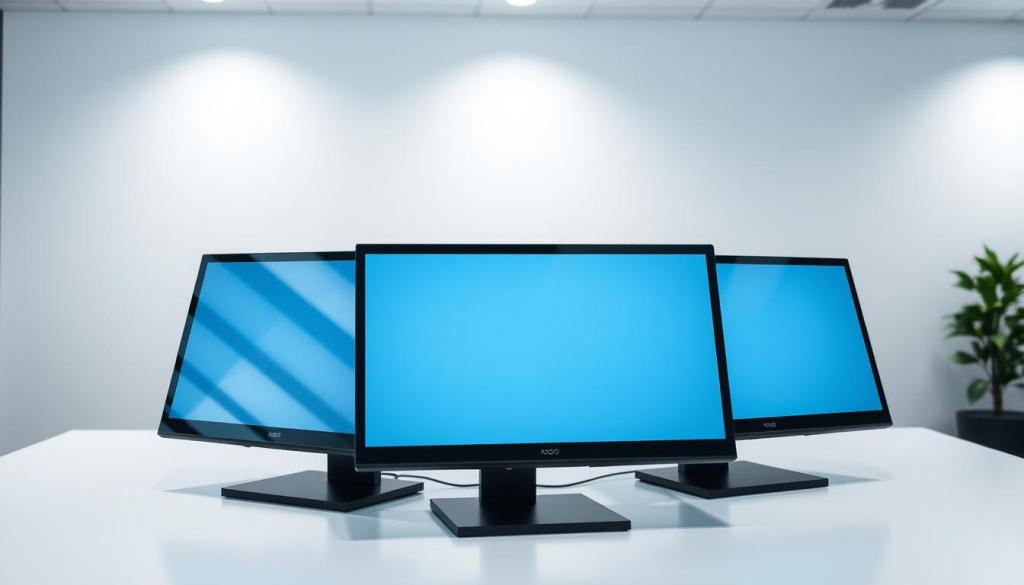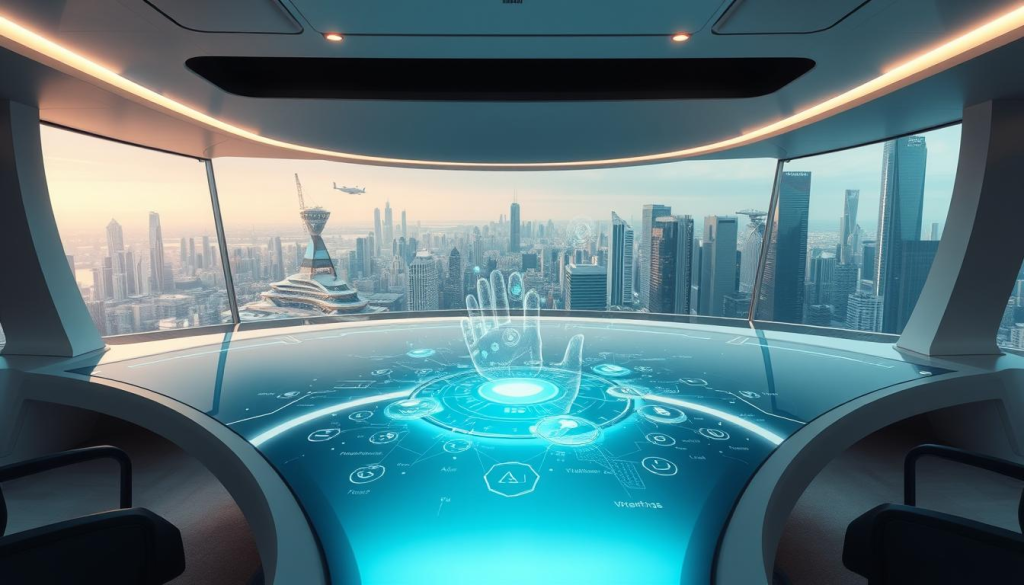In today’s world, a top-notch 22 touch screen monitor is key for both home and work. They make displays interactive, boosting user engagement and work efficiency. These monitors come in sleek designs and offer robust features, making them essential tools.
This article will help you pick the best touch screen computer monitor. We’ll make sure you choose one that fits your needs perfectly.

Key Takeaways
- 10-point touch sensitivity improves user interaction.
- Full HD resolution (1920 x 1080) is the standard for clarity.
- Available sizes range from 21.5 inches to 27 inches.
- Connectivity options are key for compatibility.
- Ergonomic stands boost comfort during long use.
Introduction to Touch Screen Monitors
Touch screen monitors are a big step forward in how we interact with devices. They mix visual and touch experiences, making them fun to use. These monitors are key in many places, like offices and homes, and even public areas.
A 22 inch touchscreen is great because it’s big enough to see well but small enough to fit easily. Touch screen tech has grown a lot. Now, we have models that can handle more than one touch at a time, making things more fun.
These monitors show things clearly with a high-resolution display, like Full HD 1080p. They’re perfect for work or digital signs. With a resolution of 1920 x 1080, they show bright, clear images.
Many people use these monitors for work because they’re fast and precise. They make switching between tasks easy. This helps teams work better together, sharing ideas smoothly.
These displays are made to be efficient and save space. They’re designed to be both useful and stylish. A 22 inch touchscreen can be the star of any workspace, adding both function and flair.
Benefits of Using a Touch Screen Monitor
Touch screen monitors are becoming popular in many fields. They make it easier for users to interact and work more efficiently. Using a space saving touchscreen monitor can change how tasks are done, making busy work environments better.
Increased Productivity
Touch screen technology boosts productivity in many areas. In healthcare, doctors can quickly find patient info, helping them make fast decisions. In retail, touch screens speed up sales and orders.
Manufacturing sees a 20% boost in productivity. This is because touch screens make data entry and navigation faster.
Improved User Experience
Touch screens offer a better user experience because they are easy to use. Users interact with them 50% more than with regular monitors. This means new employees learn faster, getting up to speed 30% quicker.
These monitors are great for people with physical challenges. Their simplicity and convenience make them very appealing.
Space Saving and Accessibility
Touch screen monitors also save space. They eliminate the need for keyboards and mice, making desks neater. This design helps people with health issues like arthritis, making computing easier.
As touch screens become more common, their advantages are clear. They offer more than just a sleek look.
Key Features to Look for in a Touch Screen Monitor
Choosing a good LCD touch screen monitor means looking at key features. These features improve how well the monitor works and how enjoyable it is to use. Important aspects include size and how clear the images are.
With many options out there, knowing what to look for helps find the right one. This ensures it meets your needs perfectly.
Size and Display Specifications
The size of a touch screen monitor is key for both looks and use. Sizes from 21.5 to 24 inches are popular for homes and offices. A 22-inch screen is a good middle ground, fitting well in smaller spaces.
Widescreen monitors offer a more immersive experience. This is great for retail and interactive settings.
Resolution and Image Clarity
How clear the images are is a top factor in choosing a monitor. Full HD, or 1920 x 1080 pixels, is common and offers sharp images. High brightness and contrast also make images clearer, even in bright rooms.
Looking for high resolution is key to getting the best picture quality.
Understanding Touch Technology
Touch technology is key in today’s interactive devices. It lets users interact with screens in smart ways. There are two main types: capacitive and resistive. Each has its own strengths and weaknesses for different uses.
Capacitive vs. Resistive Touch Technology
Capacitive touch tech is very sensitive. It responds to the electric fields from a user’s fingers. This makes it great for multi-touch, where you can use many fingers at once. It’s perfect for smooth interactions, like in the Dell P2418HT and Philips 242B9T.
Resistive touch tech is more budget-friendly. It works by using pressure from a finger or stylus. It’s good for precise work, even if it only handles single touches. Many use it, like in point-of-sale systems, for its cost and dependability.
Multi-Touch Functionality
Multi-touch screen monitors show how touch tech has grown. They can handle many touch points at once. This makes them great for places like classrooms and offices, where many people use one screen.
Connectivity Options for Touch Screen Monitors
Choosing a touch screen monitor means looking at its connectivity options. These options are key for fitting into different settings. Monitors need to connect with various devices to improve user experience.
USB Ports and HDMI Compatibility
Monitors like the Elo 02-Series come with many USB ports. This makes it easy to connect devices like storage or cameras. HDMI lets users send high-quality video and sound from computers or media players.
With these features, monitors are perfect for presentations and fun activities. They offer clear images and great sound.
Integrated Speakers and Other Ports
Many monitors have built-in speakers. This is handy for many uses. It means you don’t need to buy extra speakers.
Monitors also have HDMI, USB, VGA, and audio connectors. These options make the monitors work well in many places. They’re great for retail, healthcare, and more.
| Feature | Description |
|---|---|
| USB Ports | Multiple USB connections for diverse peripherals. |
| HDMI Compatibility | Supports high-definition video and audio output. |
| Integrated Speakers | Built-in audio system for reduced external equipment. |
| Additional Ports | Includes VGA and audio connectors for versatile setups. |
Top Considerations for Choosing a 22 Touch Screen Monitor
When picking a 22 touch screen monitor, think about what you’ll use it for. If you need it for teamwork, look for multi-touch screens. These let many people use it at once. Also, consider the monitor’s height adjustability to avoid neck pain from long hours.
Don’t forget about how well it works and how reliable it is. Reading what others say can help you choose a good brand. Make sure it has easy plug-ins like HDMI and USB-C. For tasks like graphic design, a high-resolution screen is best. But for office work, a Full HD monitor might be enough.
Think about the cost too, which matters more in offices. New touch screens also have features like blue light filters to protect your eyes. Knowing these details helps you pick the right 22 touch screen monitor.
Comparison of Leading 22 Inch Touch Screen Monitors
When picking a 22-inch touch screen monitor, it’s key to look at performance and warranties. This helps ensure you’re investing wisely. We’ll compare popular models, focusing on how well they work, their image quality, and how long they last. Knowing these details helps you make a better choice.
Performance and User Reviews
Touch screen monitors come with various features for different needs. The Elo 2201L is a top choice, with a 21.5-inch LCD display and LED technology. It’s built to last, having passed over 20 tests before hitting the market.
Its reliability is backed by a 50,000-hour mean time between failures (MTBF). Users love its multi-touch features and clear images. The 1920×1080 resolution and 16:9 aspect ratio make it great for work and school.
Value for Money and Warranty Options
There are many prices to choose from, fitting all budgets. You can find deals under $199 and more options between $200 and $499. For those looking to splurge, prices go up to $19,999.
Warranty options are also important. The Elo 2201L comes with a three-year warranty. This gives users confidence in the product’s durability and service support. Warranties add to the overall value when comparing monitors.
Best Picks for 22 Inch Touch Screen Monitors
Looking for the best 22 inch touch screen monitors? Three models are top picks for their great features and performance. They meet different needs with their touch sensitivity, display quality, and durability. Let’s dive into the ViewSonic TD2230, Elo 2201L touch monitor, and HP EliteDisplay E230t.
ViewSonic TD2230
The ViewSonic TD2230 is a 22-inch 1080p 10-point multi IPS monitor. It has a clear 1920x1080p resolution, great for detailed work. Its interface is easy to use, and it’s very sensitive to touch. It’s also affordable at $99.99, with 181 reviews showing its popularity.
Elo 2201L Touch Monitor
The Elo 2201L touch monitor is known for its reliable performance and high-quality display. It has a sleek design for various applications. Its touch technology is accurate and responsive, perfect for business and education. It also has many mounting options for easy use in different settings.
HP EliteDisplay E230t
The HP EliteDisplay E230t is a mix of beauty and function. It has a 23-inch screen, ideal for those who want a bit more space. It has a high resolution and focuses on ergonomics for comfort. With its solid connections and touch interface, it’s a top pick for quality.
Utilizing Touch Screen Monitors in Different Settings
Touch screen monitors have changed how we use technology in many places. They work well for business, learning, and fun. More people want them because they make things better in many ways.
They help teams work together better in offices. At home, they make watching movies and playing games more fun. These monitors do a lot and make a big difference.
Business and Professional Use
Businesses find touch screen monitors very useful. About 65% of companies use them to improve teamwork and work faster. They make meetings better with interactive shows and touch screens.
They also help new employees learn faster, cutting training time by half. Stores see a 40% increase in customer interest with these monitors. Touch technology really makes a difference.
Home and Entertainment Applications
At home, touch screen monitors are great for games, movies, and learning. A big 70% of users like them because they’re easy to use. The market for these monitors is expected to grow fast, thanks to better technology.
They make watching and playing more fun. This shows how touch screens can really get people involved.

Fun Ideas for Interactive Displays
Interactive displays are great for both learning and work. Teachers can use them to make school more fun and engaging. This leads to better learning for everyone.
Touch screen monitors are perfect for classroom games. Games like Pictionary or Jeopardy help students work together. They save time for teachers and give students instant feedback.
At trade shows and marketing events, interactive displays draw people in. Giant touchscreens grab attention in busy places. Activities like mini-drone racing and augmented reality games make events more fun. They also encourage people to interact and share on social media.
The table below shows different ways to use interactive displays. It highlights their unique benefits in various settings:
| Setting | Creative Use | Benefits |
|---|---|---|
| Classroom | Interactive Games | Encourages teamwork and participation |
| Trade Show | Mini-Drone Racing | Attracts large crowds, increases booth traffic |
| Retail | Customer Feedback Kiosks | Gathers valuable consumer insights |
| Corporate Events | Virtual Reality Experiences | Enhances brand memorability and interaction |
| Online Learning | MimioConnect® Tools | Improves class engagement and participation |
Interactive displays make experiences more fun and engaging. They are versatile and improve learning and marketing. They help create memorable moments for everyone.
Common Issues and Troubleshooting Tips
Touch screen monitors make using computers easy but can have problems. Issues like screens not responding, ghost touches, and wrong touch inputs are common. To fix these, it’s important to know the causes and how to solve them.
Unresponsive screens might be due to software bugs, calibration errors, or physical damage. A simple reboot often fixes minor issues. Ghost touches can be caused by dirt or pressure from screen protectors. Keeping the screen clean helps avoid these problems.
Inaccurate touch inputs can be frustrating, like when you need to be precise. Making sure the monitor is calibrated and drivers are updated is key. Dead pixels and flickering screens can also happen. These can be fixed with special software or by checking connections.
Dim or dark screens might mean the backlight is off or display settings are wrong. Checking the brightness settings regularly helps. Also, touch screens can have issues like accidental touches and environmental problems. This is more common in industrial or commercial settings.
Things like dust or moisture can mess with touch sensitivity. Wearing gloves or using the wrong tools can also affect it. Keeping software up to date and handling the screen carefully can prevent many issues.
Future Trends in Touch Screen Technology
Touch screens are changing fast, thanks to new tech. We’re seeing big improvements in how we interact with devices. This is true in many areas, like gadgets, health, and cars.
Recently, Samsung Display made the biggest OLED touchscreen display. This shows how we’re getting closer to better user experiences. Products like ViewSonic’s portable monitor also show how tech is getting better, with clearer images.

Augmented reality is making touch screens even more exciting. Capacitive touch screens are very accurate and fast. They let us do many things at once.
New tech like haptic feedback is making screens feel real. This makes using touch screens more fun and interactive.
The market for interactive kiosks is growing fast. This means we’ll see more touch screens in stores and on public transport. Schools are also using them, making learning more fun.
Technologies like gesture recognition and nanopatterns are coming soon. They will make touch screens even smarter. This will change how we interact with devices in the future.
Conclusion
Investing in a quality 22 touch screen monitor boosts interaction and productivity. It’s a great addition to both work and personal spaces. We’ve explored how the best touch screens improve user engagement and make tasks easier with their design.
Features like high resolution and many connection options highlight their value in our digital world. It’s key to think about what you need when picking a monitor. Touch screens might cost more, but their benefits are worth it.
Knowing the challenges of touch screen tech, like battery life and driver issues, helps avoid problems. This makes for a better experience.
This summary shows touch screen technology’s growing importance. As display tech improves, future touch screens will offer even more features. They will become vital for better interaction in many areas.
FAQ
What is a 22 touch screen monitor?
A 22 touch screen monitor is a screen that you can touch. It’s 22 inches across and lets you interact with it directly. People use them for work and fun.
What are the benefits of using a touch screen monitor?
Touch screen monitors make work easier by letting you tap on the screen. They offer a better experience and save space. You don’t need keyboards or mice.
How do capacitive and resistive touch technologies differ?
Capacitive screens are super sensitive and work with gestures. They’re great for interactive stuff. Resistive screens are cheaper and very accurate. They’re good for precise tasks.
What should I consider when choosing a 22-inch touchscreen monitor?
Think about what you’ll use it for, its resolution, and how it connects. Look at multi-touch, ergonomics, and what others say. Make sure it fits your needs.